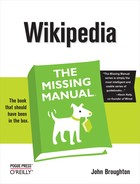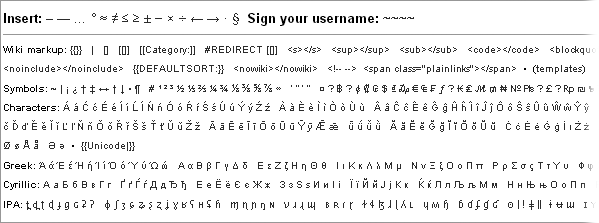When you click “edit this page” or the “edit” link for a section, the page’s format changes.
At the top of the page when you’re in editing mode, you see the edit toolbar (Figure A-2).
Figure A-2. The edit toolbar is always just above the edit box, near the top of the page. If you’re not sure what an icon does, just move your mouse pointer to one of the icons and see what the tooltip says.
Most icons on the toolbar work in either of two ways:
If you select text and then click an icon, then you format the selected text.
If you don’t select any text, then when you click on an icon, the software adds and formats some sample text for you, highlighting it so you can be replace it with your own text.
Exceptions to this are the signature icon, the horizontal line, the line break, and the table insertion icon, which aren’t formatting actions. Instead, they insert specific text into the edit box, wherever the cursor is.
Note
Don’t highlight text before clicking the table icon, because the resulting table is probably going to be too simple for your needs. See Creating Tables for more detail on creating tables.
One preference lets you hide the edit toolbar if you never use it (see Figure 20-9, fifth option). If you haven’t turned the toolbar off, but you don’t see it, or it doesn’t function correctly, then you may not have JavaScript turned on (see Setting Up Your Browser).
The edit box is where you find (or enter) the wikicode that creates content for a Wikipedia page. If you’re creating a page, it starts out as a big, empty box. You can specify the size of the edit box in your preferences (see Editing).
A number of essential things are located just below the edit box (Figure A-3).
Figure A-3. Below the edit box is a box to enter the edit summary for the change you’re making to the page you’re editing, plus two checkboxes, three buttons, and three links.
Edit summary. As discussed on Previewing, always explain your edit by putting something into the edit summary box.
“This is a minor edit” checkbox. Turn on this box if you’re making an edit that’s so tiny it could never be the subject of dispute—like changing a misspelling or punctuation. Page 108 has more details about edits marked as minor.
Tip
You can change a setting so this box is always checked by default (and you uncheck it only as needed). See ???.
“Watch this page” checkbox. Adds a page to your watchlist (Adding Pages to Your Watchlist).
Cancel. Cancels your edit and goes back to reading mode.
Editing help. Opens the page Wikipedia:Cheatsheet, which has some fairly basic editing information. (The shortcut is WP:CHEAT, if you want to get there via the search box.)
Copy warning. Has a link to GNU Free Documentation License, which explains the “copyleft” license used by Wikipedia to release its pages as free content.
Note
In December 2007, the Wikimedia Foundation requested that this license be modified to allow the Foundation to move all its projects, including Wikipedia, to a different free content license, Creative Commons CC-BY-SA. If that happens, you’ll see a different link, which explains whatever new licensing scheme is in place.
“Save page” button. Click here when you’ve finished your edit. (Don’t forget to enter an edit summary and preview the page first.)
“Show preview” button. It’s always a good idea to check your work before saving it (Previewing).
“Show changes” button. Shows the difference, above the edit box, between the current version of the section or page you’re editing and the section or page as you’ve changed it. (In other words, it’s a diff of your yet-to-be-saved edit.) It’s useful if you’ve forgotten what you’ve done; or to check whether you’ve deleted some text by mistake; or to recover some deleted text without having to go back to the article, in another window, and copy from there.
Moving further down the page, you find a large amount of text in blue, as shown in Figure A-4. Clicking one of these items inserts something into the edit box—something that would otherwise require a lot of typing or cryptic codes.
Below the insertable text is a link to the Sandbox, for risk-free editing. (There’s more on the sandbox on Practicing in the Sandbox.) Then there are several notes directed to you as an editor, including one that’s often quoted when ownership issues arise concerning an edit: “If you don’t want your writing to be edited mercilessly or redistributed for profit by others, do not submit it.”
Finally, at the very bottom of the edit window is a list of transcluded pages—generally, but not always, these are templates (Understanding and Using Templates). This list is extremely helpful in figuring out, on the rare occasions that page displays are odd, whether the problem might be in the wikicode that a template adds to a page.


